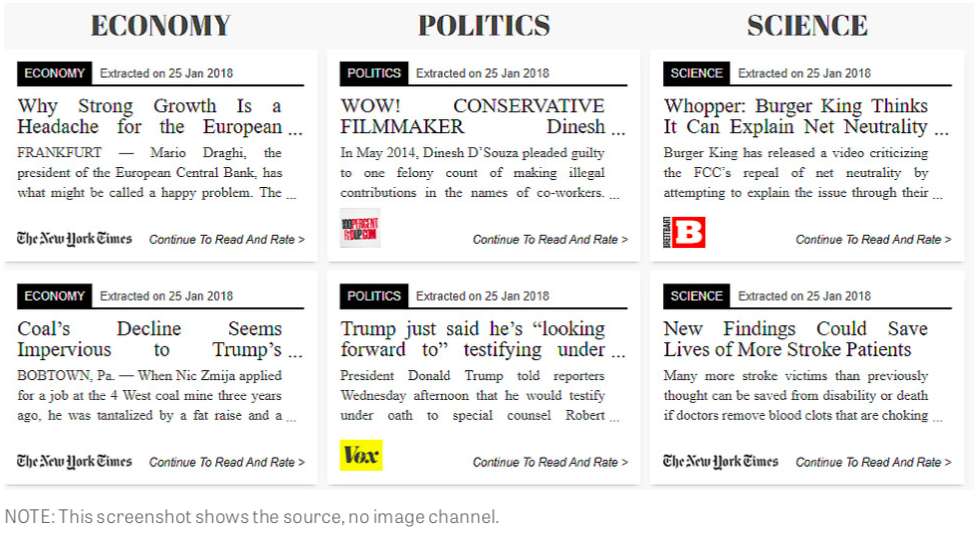
That’s the finding from more than 3,000 U.S. adults who looked at and rated the trustworthiness (on a scale of 1 to 5) of articles over a four-week period via an online platform built by Knight Foundation and Gallup specifically to study people’s reactions to news content. The stories participants evaluated came from the “pre-identified media outlets” Media Matters, Vox, The New York Times, AP, Fox News, Breitbart News, and 100PercentFedUp. (Disclosure: Knight has been a funder of Nieman Lab.)
Users were shown news articles in the categories of economics, politics, and science under one of four design conditions:

The Gallup-Knight study found that:
Channels with source attribution had a lower overall mean trustworthiness rating per article, dropping from 3.22 to 3.08 in channels with no images and 3.23 to 3.07 in channels with images.
The effect of attaching an image to content was similar at 3.22 to 3.23 in channels with no source attribution and 3.08 to 3.07 in channels with source attribution. Images selected for content do not seem to affect the overall trustworthiness level.
We find no statistically significant difference in the effect between those who rated more, or fewer, articles.
Trustworthiness ratings dropped when readers in this study saw Vox, Fox, or Breitbart as the source of a news article. When its content was evaluated by people who didn’t see the source label, Vox achieved about the same mean trustworthiness score per article as AP or The New York Times. Among the seven sources the study looked at, the AP and Times had the highest mean trustworthiness score per article. Breitbart News, 100PercentFedUp, and Media Matters ranked lowest in trustworthiness even when readers didn’t see them labeled.

Just as a general note, it’s consistently jarring to see news operations like “The New York Times” and “The Associated Press/AP” on the same spectrum to the left of a “news” site called “100PercentFedUp,” which publishes good faith, fact-based journalism such as “THIS IS AMAZING: In 1984, the New York Times said Trump would be our BEST president…They forgot.” (This particular story, later given a new headline, now comes with this glorious correction: “We like to think our readers can think subjectively and “get” our nuanced titles once they read the article…We believe that the New York Times INADVERTENTLY DESCRIBED HOW TRUMP WOULD BE A PERFECT FIT FOR THIS TIME IN AMERICA, therefore, THE BEST PRESIDENT ‘FOR THIS TIME IN AMERICA'”.)
Partisanship is clearly at play in these findings of trustworthiness. The study found:
Democrats and Republicans both favor sources representing their ideological preference when source is hidden, but Democrats appear to make a sharper distinction.
Interestingly, Democrats appear to view content from The Associated Press/AP as more trustworthy when source is shown, while Independents and Republicans show no change or a decrease in trustworthiness depending on the channel comparison.
The full study is available here.